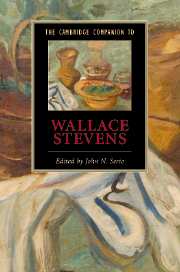Book contents
- Frontmatter
- Introduction
- 1 Wallace Stevens: A Likeness
- 2 Stevens and Harmonium
- 3 Stevens in the 1930s
- 4 Stevens and the supreme fiction
- 5 Stevens’ late poetry
- 6 Stevens and his contemporaries
- 7 Stevens and romanticism
- 8 Stevens and philosophy
- 9 Stevens’ seasonal cycles
- 10 Stevens and the lyric speaker
- 11 Stevens and linguistic structure
- 12 Stevens and painting
- 13 Stevens and the feminine
- 14 Stevens and belief
- Further reading
- Index
6 - Stevens and his contemporaries
Published online by Cambridge University Press: 28 May 2007
- Frontmatter
- Introduction
- 1 Wallace Stevens: A Likeness
- 2 Stevens and Harmonium
- 3 Stevens in the 1930s
- 4 Stevens and the supreme fiction
- 5 Stevens’ late poetry
- 6 Stevens and his contemporaries
- 7 Stevens and romanticism
- 8 Stevens and philosophy
- 9 Stevens’ seasonal cycles
- 10 Stevens and the lyric speaker
- 11 Stevens and linguistic structure
- 12 Stevens and painting
- 13 Stevens and the feminine
- 14 Stevens and belief
- Further reading
- Index
Summary
Back in the twentieth century, when such distinctions seemed to matter, readers often paired Wallace Stevens with other poets in order to highlight their differences. Hugh Kenner summed up Stevens' relationship with William Carlos Williams as “one of the most extraordinary misunderstandings in literary history.” Marjorie Perloff asked the question “Pound/ Stevens: Whose Era?” Many people delighted in repeating this anecdote about Stevens and Robert Frost: “The trouble with you is you write about things,” Stevens said to Frost. “The trouble with you is you write about bric-a-brac,” Frost retorted.
Why the need to make Stevens stand apart? Stevens and Williams first met in New York in 1915, became close friends for the next decade and, despite the pressure of diverging careers, remained supportive of each other's work until the end of their lives. Stevens and Frost were not close friends, but both poets attended Harvard in the late years of the nineteenth century, absorbing there the pragmatist philosophy of William James. Marianne Moore, friend of both Williams and Ezra Pound, admired Stevens' poetry from its beginnings; by the time they finally met face to face in 1943, each poet had written crucial accounts of the other's career. Elizabeth Bishop, Randall Jarrell, James Merrill, John Ashbery - major figures from each subsequent generation of American poets - have been shaped by Stevens' seriously playful sensibility.
- Type
- Chapter
- Information
- The Cambridge Companion to Wallace Stevens , pp. 76 - 86Publisher: Cambridge University PressPrint publication year: 2007

